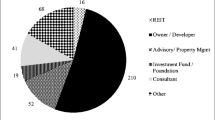Abstract
This paper has two goals: (a) To model an inherent conflict of interest between a seller of a house and the real estate broker hired by the seller. In this environment, the pressure brokers exert on sellers to reduce prices generates faster sales and hence reduces sellers’ expected profit. (b) To calibrate the brokers’ commission rates that would maximize sellers’ expected gain. The calibration results may hint whether the ongoing uniform commission rate reflects collusion among real estate agencies, or should be viewed as competitive.



Similar content being viewed by others
Notes
Clearly, the seller has the final say on the price. However, in many cases, real estate brokers have a great deal of influence on sellers’ pricing decisions, basically by providing certain information on the market thereby leading the seller to believe that the price must be lowered. In this case, the assumption that brokers set the price is not that far from reality. Brokers often exert pressure on buyers to lower their price by telling sellers that they will not be able find buyers at the price they want.
As mentioned in the introduction, sellers in the United States generally pay 6% commission and rarely bargain with their brokers on lower rates. Thus, it makes sense to assume that the commission rate is exogenously given.
I thank the referee for suggesting this extension.
References
Anglin, P., & Arnott, R. (1999). Are brokers’ commission rates on home sales too high? A conceptual analysis. Real Estate Economics, 27(4), 719–749.
Arnold, M. (1992). The principal-agent relationship in real estate brokerage services. Real Estate Economics, 20(1), 89–106.
Biglaiser, G. (1993). Middlemen as experts. RAND Journal of Economics, 24(2), 212–223.
Biglaiser, G., & Friedman, J. (1994). Middlemen as guarantors of quality. International Journal of Industrial Organization, 12(4), 509–531.
Carroll, W. (1989). Fixed-percentage commissions and moral hazard in residential real estate brokerage. The Journal of Real Estate Finance and Economics, 2,(4), 349–365.
Commission, Federal Trade & U.S. Department of Justice (2007). Competition in the Real Estate Brokerage Industry.
Crawford, V., & Sobel, J. (1982). Strategic information transmission. Econometrica, 50(6), 1431–1451.
Fisher, L., & Yavas, A. (2010). A case for percentage commission contracts: The impact of a “Race” among agents. The Journal of Real Estate Finance and Economics, 40(1), 1–13.
Garella, P. (1989). Adverse selection and the middleman. Economica, 56(223), 395–400.
Genesove, D., & Mayer, C. (2001). Loss aversion and seller behavior: Evidence from the housing market. Quarterly Journal of Economics, 116(4), 1233–1260.
Hackett, S. (1992). A comparative analysis of merchant and broker intermediation. Journal of Economic Behavior & Organization, 18(3), 299–315.
Hackett, S. (1993). Consignment contracting. Journal of Economic Behavior & Organization, 20(2), 247–253.
Hendel, I., Nevo, A., & Ortalo-Magne, F. (2009). The relative performance of real estate marketing platforms: Mls versus fsbomadison.com. The American Economic Review, 99(5), 1878–1898.
Knoll, M. (1988). Uncertainty, efficiency, and the brokerage industry. Journal of Law and Economics, 31(1), 249–263.
Levitt, S., & Syverson, C. (2008). Market distortions when agents are better informed: The value of information in real estate transactions. The Review of Economics and Statistics, 90(4), 599–611.
Merlo, A., Ortalo-Magné, F., & Rust, J. (2008). The home selling problem: Theory and evidence. Tech. rep., University of Maryland Working Paper.
Riley, J. (2001). Silver signals: Twenty-five years of screening and signaling. Journal of Economic Literature, 39(2), 432–478.
Rubinstein, A., & Wolinsky, A. (1987). Middlemen. The Quarterly Journal of Economics, 102(3), 581–593.
Salant, S. (1991). For sale by owner: When to use a broker and how to price the house. The Journal of Real Estate Finance and Economics, 4(2), 157–173.
Schroeter, J. (2003). Competition and value-of-service pricing in the residential real estate brokerage market. Iowa State University, Department of Economics, Staff General Research Paper.
Tversky, A., & Kahneman, D. (1991). Loss aversion in riskless choice: A reference-dependent model. The Quarterly Journal of Economics, 106(4), 1039–1061.
Yavas, A. (1994). Middlemen in bilateral search markets. Journal of Labor Economics, 12(3), 406–429.
Zorn, T., & Larsen, J. (1986). The incentive effects of flat-fee and percentage commissions for real estate brokers. Real Estate Economics, 14(1), 24–47.
Acknowledgements
I thank an anonymous referee, Mary Burke and Suzanne Lorant for most valuable comments and suggestions on an earlier draft. The views and opinions expressed in this paper are those of the author and do not necessarily represent the views of the Federal Reserve Bank of Boston or the Federal Reserve System.
Author information
Authors and Affiliations
Corresponding author
Appendix: Derivation of Equation 6
Appendix: Derivation of Equation 6
The right side of Eq. 6 can be written as
Since each bracket term constitutes a converging sequence, the above equals to
Rights and permissions
About this article
Cite this article
Shy, O. Real Estate Brokers and Commission: Theory and Calibrations. J Real Estate Finan Econ 45, 982–1004 (2012). https://doi.org/10.1007/s11146-010-9296-6
Published:
Issue Date:
DOI: https://doi.org/10.1007/s11146-010-9296-6



